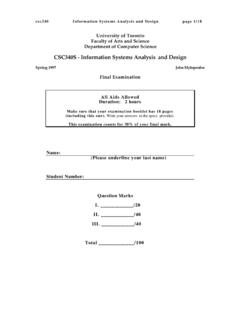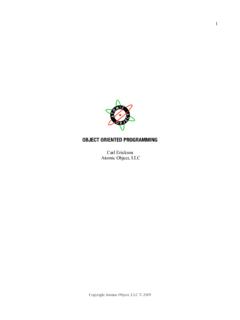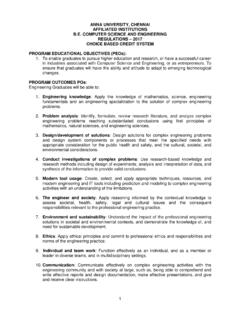Transcription of Case Study - Massachusetts Institute of Technology
1 CASE Study Boeing Commercial Airplane Group Wichita Division (Boeing Co.) Employing Activity Based Costing and Management Practices Within the Aerospace Industry: Sustaining the Drive for Lean Summary Who: Boeing Commercial Airplane Group Wichita Division Where: Wichita, Kansas, Boeing Commercial Airplane Group When: First Visit: Rocco Paduano and Wesley Harris, November 1999; Second Visit: Rocco Paduano, Wesley Harris and Joel Cutcher-Gershenfeld, May 2000 Why: Completion of Activity Based Costing and Management pilot What: Assessment of lessons learned and economic benefits gained Introduction Activity Based Costing and Management (ABCM) is one of many new financial and accounting tools aimed at providing more complete, better-aligned data on economic performance.
2 It is important to explore early experiences with this concept since it represents a new set of rules that can have implications for all stakeholders in an aerospace enterprise. ABCM is of particular interest with respect to lean practices and principles since it links the cost of production or services to the relevant support activities, which is helpful in targeting continuous improvement efforts. For example, time spent in training will be differentiated from time spent on production of a given product. This leads to a more accurate allocation of overhead charges.
3 Formerly such costs may have been allocated in ways that obscured their source. Companies who are focusing resources on organizational learning initiatives will also find that ABCM processes add value to these efforts. Employees engaged in operational improvement and activity measurement are also becoming more informed and aware of potentially valuable organizational For example, the true costs of efforts such as cycle time reduction and quality improvement can be clarified with the addition of activity-based costing techniques. the cost of production or services to the relevant support activities.
4 The motivation for ABCM lies in the value of recognizing true costs, which will assist managers and other leaders in making critical choices, such as the decision to manufacture goods internally, rather than involve an external contractor. It will also help managers understand how their decisions can impact bottom line shareholder value. In principle, ABCM is designed to help firms shift their priorities from individual products to the overall manufacturing environment. 1 Kaplan, R. S. and R. Cooper 91998). Cost & Effect: Using Integrated Cost Systems to Drive Profitability and Performance.
5 Boston, Harvard Business School Press. 1 A recent national Study of aerospace facilities suggests that ABCM practices are more common among suppliers. 2 The Study also found ABCM to be more common in smaller facilities, producing multiple distinct products, in medium to high manufacturing volume. In one sample of 196 aerospace facilities, less than 5% of the facilities reported high-level usage of ABCM principles. This case Study hopes to deepen understanding of ABCM principles by looking beyond the survey data and tracing early experience in an aerospace setting. Note that these are just pilot demonstration initiatives and do not represent full-scale implementation.
6 In presenting this Study , we are not advocating for or against this particular approach to financial accounting just seeking to better understand its implications. The Study is located in a large final assembly operation: The Boeing Commercial Airplane Group (BCAG) Wichita Division of the Boeing Company (hereafter referred to as BCAG Wichita). BCAG Wichita is a cost center that has introduced ABCM. It is designed to support a comprehensive lean production strategy encompassing everything from asset management, to design for manufacturability, to cost of quality.
7 This case Study contains two examples of ABCM modeling, which include tracking the benefits that can be gained through effective ABCM implementation. The overarching metric for both examples is cost savings through activity analysis designed to uncover non-value added processes that depress value creation capabilities. Middle management originated and championed both of these ABCM initiatives. The Study describes a number of barriers and enablers to widespread adoption of ABCM at the facility level. The most critical element in the success of these implementation projects was the ability to change ingrained elements of organizational culture.
8 Background: The Cost Management Strategy BCAG is the world s largest manufacturer of commercial airplanes. It comprises approximately 60% of Boeing s total revenues. BCAG Wichita is a cost center manufacturing plant producing fuselages, noses, struts, nacelles, and thrust reversers for 737, 747, 757, 767, and 777 airplane models. In May 1999, the plant employed approximately 16,835 employees directly, and was responsible for indirect employment of 53,100 workers within the state of Kansas. It averaged 2 2 MIT/LARA National Survey of the Aerospace Industry, 2000.
9 $ billion in annual payroll, purchased $900 million yearly in raw materials and purchased parts, boasted 100,000+ part numbers, occupied an area equivalent to 1,300 acres, and its manufacturing facility covered million square feet. As part of its overall drive to gain and retain world-class aerospace manufacturing status, BCAG Wichita is focused on developing a lean, efficient design and production system supported by an effective cost management strategy. The cost management strategy supports initiatives designed to link the manufacturing process and support activities so as to simplify the whole production process, while maximizing benefits from the use of lean business practices.
10 Cost management strategy initiatives include simplifying production, shortening flow and cycle times, increasing quality and inventory turnover, identifying core products and processes, and linking the design and manufacturing process to decrease product time-to-market. ABCM links and supports the manufacturing process. It provides information to tailor business streams and material management, costs of activity and processes, value added versus non-value added analysis and profitability analysis used to improve the make versus buy decision-making process.


















